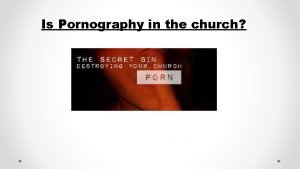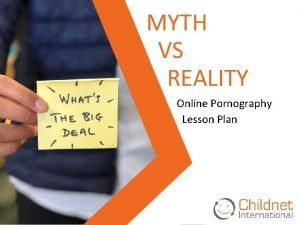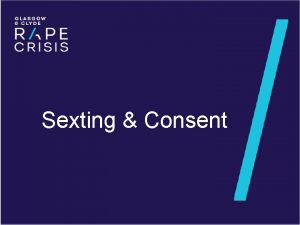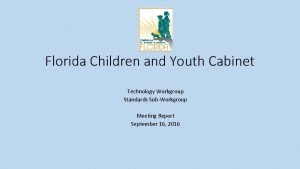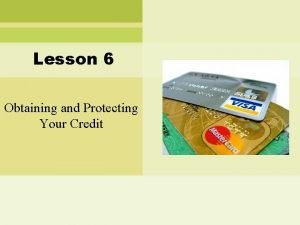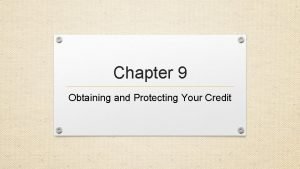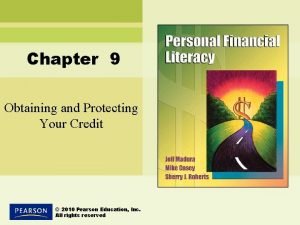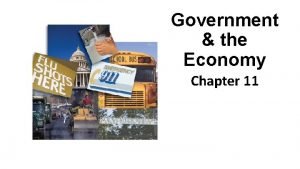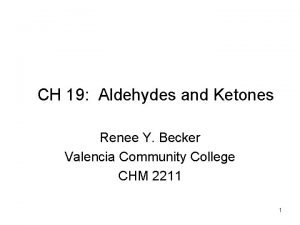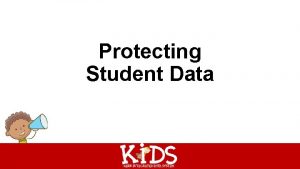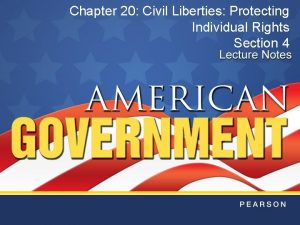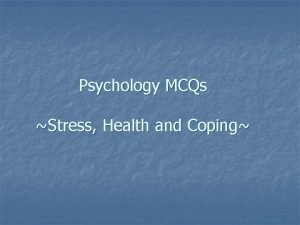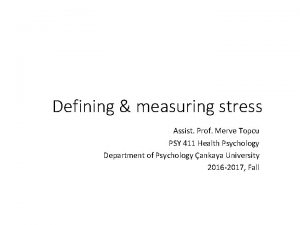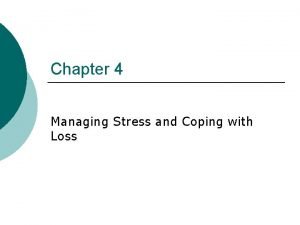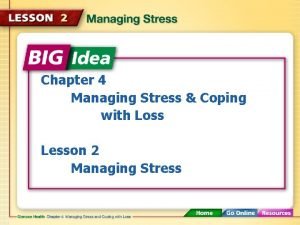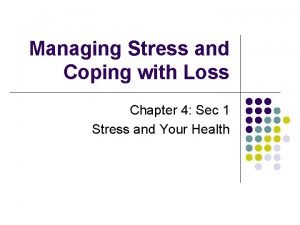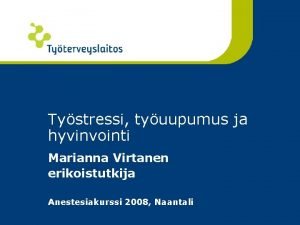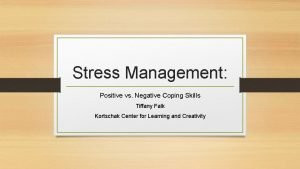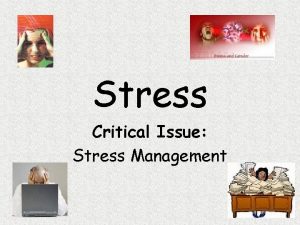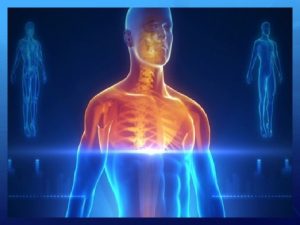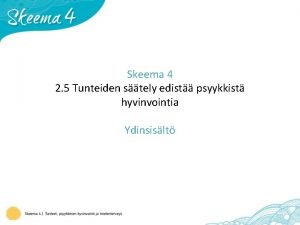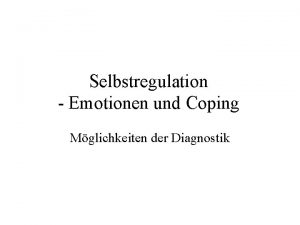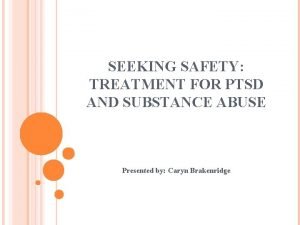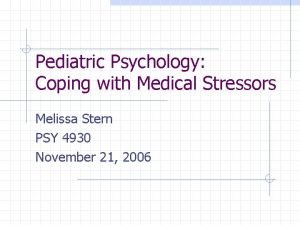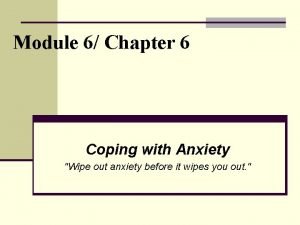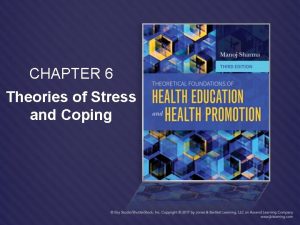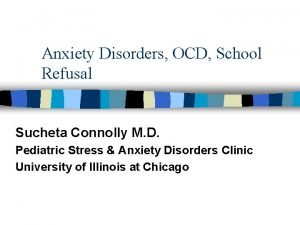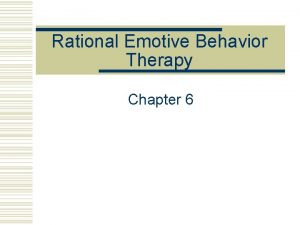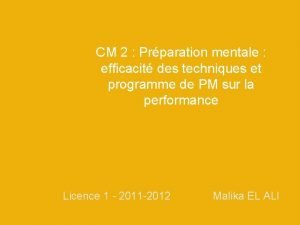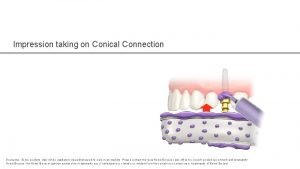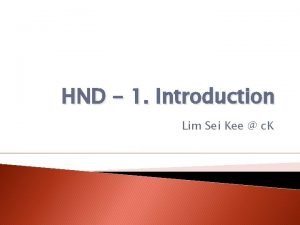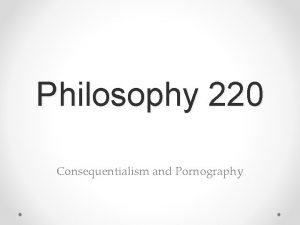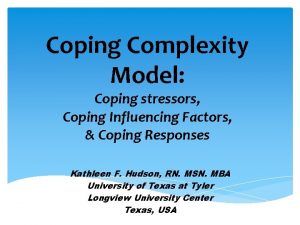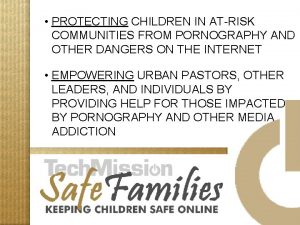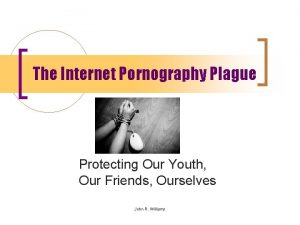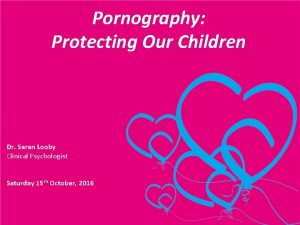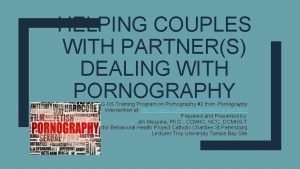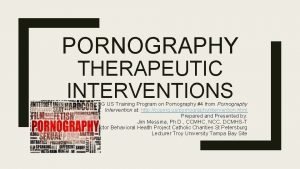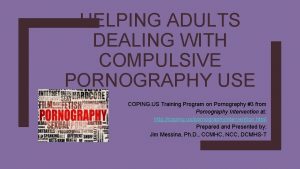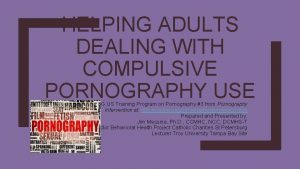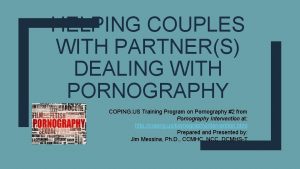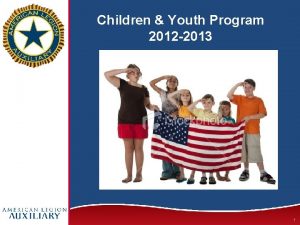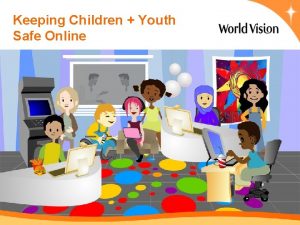PROTECTING CHILDREN AND YOUTH FROM PORNOGRAPHY COPING US































































- Slides: 63

PROTECTING CHILDREN AND YOUTH FROM PORNOGRAPHY COPING. US Training Program on Pornography #1 from Pornography Intervention at: http: //coping. us/pornographyintervention. html Prepared and Presented by: Jim Messina, Ph. D. , CCMHC, NCC, DCMHS T

Description of Preventing Children and Youth from Pornography - Program #1 This program takes a prevention orientation to an emerging epidemic of internet pornography which enters the homes of families earlier and earlier with reports that children as young as 8 years of age have been exposed to it. There is a need to conduct community wide educational programming to awaken parents to this crisis and to help them develop strategies on how to deal with it in their families. The need to put monitors on all electronic devices and to limit usage of these devises to public environments in the home which parents can easily oversee is just one concept to be explored. Learning Objectives 1. To learn about the impact of pornography on youth in America today with an exploration of what types of pornography are out there and on what platforms they are present. 2. To learn about the neuroscience of watching pornography which leads to the compulsive need for more pornography to satisfy the mesolimbic reward centers of the brain. 3. To learn techniques which parents can use to have the "talk" with their children prior to and immediately after their exposure to pornography to prevent the movement toward compulsive viewing of it as the child’s brain increasingly craves it after extended exposure to it. 4. To learn about the resources to supplement the delivery of pornography prevention services in the community, school and family so that the children are kept safe from this new attack on their mental health.

IMPACT OF PORNOGRAPHY ON CHILDREN & YOUTH

Why Now? ■ In 2006 with the introduction of High Speed Internet systems the world has been turned upside down when it come to Pornography and the ease of its accessibility ■ No one dreamed of this problem which is now at epidemic proportions ■ In 2010 the Professional Literature began to be crowded with research on the impact of internet pornography or cybersex ■ Today there is enough documentation to convince mental health professionals, pastoral leaders, school officials and governmental agencies that there is a whole new study out there about the prevention of compulsive pornography use by children, teens, young adults, and married partners ■ The time has come to deal with this issue seriously and for this reason Coping. US Training Programs has 4 distinct programs on Pornography Intervention ■ They are: – Pornography Prevention Program Strategies for parents with children and teens – Pornography Intervention for Couples – Pornography Intervention for Adults – Pornography Therapeutic Interventions for Mental Health Professionals

Impact of Pornography on Youth in America ■ The concern about the use and impact of pornography falls within the responsibility of how each family transmits sexual values and expectations. As a number of experts have cautioned, if the first conversation about sex that you have with your children is the result of discovering their Internet use, then you have not done your job as a parent. ■ Pornography is value laden and as such should be viewed through the lens of each family’s value structure, just as we raise our children to deal with the many other challenges they will confront. It is at this point that our role as religious leaders and mental health professionals takes on greater clarity; not to stem the tide of pornography – we simply cannot, but to help families prepare their children for the endless stream of sexual messages which permeate our world, some more invasive than others. As we seek to help families avoid or cope with this abuse, so we must help them raise children in a world that seems to change with unprecedented regularity. We then have the gift of preventing problems and not just treating them (from: The Pornography Question by David S. Ribner, 2014)

What is the Current View of Porn by In. Youth? a 2016 study the Barna Group found the following: ■ What is Porn? The study found that the most significant factor for considering an image as porn was if the image involved sexual intercourse and that sexual plays an important factor in a person considering an image as porn ■ Teens and young adults consider more types of images as porn than do adults ■ Teens and young adults consider not recycling more immoral than viewing porn ■ Young Adults ages 18 24 are least likely to say that porn is bad for society ■ More than half of teens and young adults speak of porn in a way that is completely accepting and only a small percentage talk about porn in a disagreeable way ■ Only child pornography and "painful sex" are considered "always wrong" by a majority of people ■ Two thirds of teens and young adults have received a sexually explicit image from their girl/boyfriend or friend This 2016 study was done by the Barna Group for Covenant Eyes, Inc. The Report is called: The Porn Phenomenon: Survey of US Teens and Adults at

What are Pornography Websites? ■ In 2008, the company Hitwise catalogued 40, 634 websites that distributed pornography (Tancer, 2008). ■ According to the research by two neuroscientists in 2010, out of the one million most trafficked websites in the world, 42, 337 are sex related sites (Ogasa & Gaddam, 2011). ■ Free websites comprise between 70 80% of the adult material online, typically used as “bait” for pay websites, guiding viewers to premium pay services (Zook, 2007). ■ A conservative estimate places 32% of adult membership websites and 58% of free adult websites outside the United States (Zook, 2007). ■ 90% of free porn websites and nearly 100% of pay porn websites buy their material rather than create it themselves (Zook, 2007).

What are Pornography Websites? ■ In 2009, the Media Research Center (MRC) examined the most popular You. Tube searches for the word “porn, ” yielding 330, 000 results. The study reported on the top 157 videos, all with one million views or more. ■ Two thirds of the videos advertise themselves as being actual pornography. ■ Many videos feature clips from actual porn movies, interviews with porn stars, advertisements for porn sites, and phone sex lines. ■ Profanity is commonplace in the titles and comments for the videos. ■ There are suggestions of sex with computers, virtual reality sex, sex in multiplayer online video games and the merging of pornography with independent cinema are thing of the future. Perhaps two decades from now the seemingly immovable Internet as the go to porn distribution tool will be as dead and buried as VHS (Nielsen & Kiss, 2015).

Numbers of Youth Viewing A 2016 review of the research in the field reported that: Pornography ■ About 46% of US men and 16% of women watch porn in a given week ■ Between 6% and 28% of male porn users describe their habit as "problematic" ■ Many ex users report impressive benefits like better sleep, clearer skin and more confidence ■ Boys are starting to regularly use porn at an increasingly earlier age of 8 for the youngest in one survey thus it is vital to educate children and teens explaining that pornography may not accurately depict sex and relationships ■ Study after study shows that self identified porn addicts are not watching more porn than other people, but have moral values that conflict with their use (Wilson, 2016). A 2017 study found the following: ■ Adolescents aged 15 16 years, especially male adolescents, are the most prone to the development of Internet (pornography)addiction ■ Adolescents aged 11 12 years show the lowest level of Internet (Pornography) addiction

Pornography Has Gone Mobile ■ When 1, 521 smartphone owners in the UK. ages 18 and older were surveyed, 24% admitted to having pornographic material on their mobile handset. Of these, 84% of those who were involved in a romantic relationship said their partner did not know about the porn on their handset (Covenant. Eyes, 2015). ■ In 2012, 43. 8% of adult industry executives and stakeholders believed mobile devices would become consumers’ primary porn viewing devices (XBIZ Research, 2012). ■ According to Juniper Research, by 2017, a quarter of a billion people are expected to be accessing mobile adult content from their phones or tablets, an increase of more than 30% from 2013. Mobile adult videochat alone will have a compound annual growth rate of 25% (Juniper Research, 2013). ■ Nearly 1 in 5 searches made from mobile devices are for pornography. Furthermore, 24% of smartphone owners have porn on their handset, and of these, 84% said their romantic partners did not know about it (Eldred, 2012). ■ Teens and young adults in particular, use smartphones, and are therefore at a higher risk of Internet misuse on their mobile devices. One study found that 51% of 18 34 year olds own smartphones. Meanwhile, 49% of teens use the Internet on a mobile device (Eldred, 2012).

Digital Divide: How the Online Behavior of Teens is Getting Past Parents (Mc. Afee, ■ In 2012, research done by Mc. Afee an internet provider, conducted by 2, 017 online 2012) interviews with teens, ages 13 17, and parents of teens. ■ This report with led off with this quote: "The fact is that allowing teens to participate in unmonitored online activity exposes them to real dangers with real consequences, and these dangers are growing exponentially with the proliferation of social networks" This study found that: ■ 71% of teens have done something to hide what they do online from their parents (this includes clearing browser history, minimizing a browser when in view, deleting inappropriate videos, lying about behavior, using a phone instead of a computer, and blocking parents with social media privacy settings, using private browsing, disabling parental controls, or having e mail or social media accounts unknown to parents). ■ 32% of teens admit to intentionally accessing nude or pornographic content online. Of these, 43% do so on a weekly basis. Only 12% of parents knew their teens were accessing pornography.

Mc. Afee 2012 Study exposed 10 ways teens hide their online activities from their ■ Clearing the browser history (53%) parents: ■ Close/minimize browser when parent walked in (46%) ■ Hide or delete IMs or videos (34%) ■ Lie or omit details about online activities (23%) ■ Use a computer their parents don’t check (23%) ■ Use an internet enabled mobile device (21%) ■ Use privacy settings to make certain content viewable only by friends (20%) ■ Use private browsing modes (20%) ■ Create private email address unknown to parents (15%) ■ Create duplicate/fake social network profiles (9%)

Major Conclusion from Mc. Afee 2012 Study “While it is not necessarily surprising that teens are engaging in the same types of rebellious behaviors online that they exhibit offline, it is surprising how disconnected their parents are. There is a major increase in the number of teens finding ways to hide what they do online from their parents. This is a generation that is so comfortable with technology that they are surpassing their parents in understanding and getting away with behaviors that are putting their safety at risk. ” In addition to putting themselves in risky situations, teens are finding that much of this online behavior is attributing to personal problems. In fact, over half of teens with a social network account have already experienced negative consequences as a result of being on a social network account, such as: arguing with friends (35. 4%); getting into trouble at home or school (25. 2%); ending friendships (20%); fearing for their safety (6. 8%) and physical fights (4. 5%). Conversely, many parents live in denial, with only 22% claiming that their teens can get into that much trouble online.

Results of COX Communications: 2014 Teen Internet Safety Survey (Cox Communications, 2014) In 2014 Cox Communications published their latest internet safety survey results. Top Three Points in Survey Results: 1. More than half of teens have witnessed cyberbullying on social media. 2. Smartphones are quickly becoming the go to device for online activity. 3. Nine in 10 teens say their parents have talked to them about online safety. Time Spent online: Teens report spending several hours a day online via many devices: ■ On average, teens spend 5 hours and 38 minutes online every day ■ Nearly half of that time is spend playing online games ■ Numbers vary slightly among different demographics ■ Younger teens spend slightly less time at 5 hours and 15 minutes ■ On average, male teenagers spend an hour more than female teens playing online games

More Results of the COX Communications 2014 Study Devices Used 99% of teens access Internet via a “Mobile” Device: ■ 81% Smartphone ■ 84% Laptop ■ 61% Tablet ■ 43% MP 3 Player with Internet access ■ 40% Handheld Gaming Device with Internet Access ■ 32% E Reader with Internet Access Interacting Online 92% are social network users & share online: ■ Photos or videos (74%) ■ Age (47%) ■ Risky online comments or posts (24%) ■ Physical location (21%) ■ Cell phone number (15%) ■ Address (9%)

Cox Study Results on Parent Monitoring With the increase of teens using mobile devices and social media, there is an increase in parent discussions about Internet Safety: ■ 9 in 10 teens say their parents have talked to them about Internet safety. Among those: ■ 86% say the talk has occurred within the last year. ■ However, nearly half (49%) of teens claim their parents do nothing to monitor their devices. Hiding Content: More parents are working to protect their teens online, however: ■ Nearly half of teens admit to taking action to hide their online behavior from parents ■ 46% have cleared their search history and/or cookies on their browser ■ 1 in 5 have used a private browsing feature so their parents can’t see the sites they’ve visited ■ A few (8%) have disabled the software their parents installed on the internet device (Cox Communications, 2014)

Teens and Sexting –Study Results Sexting is sending or posting a sexually suggestive nude or nearly nude photo or video of oneself. A 2013 study found that older teens are more likely to report having sent a sext: ■ 4% of 12 year olds have sent a sext ■ 7% of 14 17 year olds have sent a sext ■ 9% of 13 18 year olds have sent a sext ■ 19% of 18 24 year olds have sent a sext ■ 21% of black and Hispanic youth in 10 th grade have sent a sext (Peskin, Markham, Addy, Shegog, Thiel & Tortolero, 2013)

Teens and Sexting –Second Study Results A 2014 study found a link between media socialization and engagement in music video and pornography consumption in sexting behavior. Results demonstrated that sexting behaviors were significantly associated with the consumption of pornography, when controlling for age, gender, school track and Internet use and the significant relationship between engagement in the four types of sexting behavior: 1. sending a text message about sex (e. g. , an instant message, e mail, or text message) to someone else 2. sending a sexually suggestive picture or video or had a sexually suggestive webcam conversation in which they were depicted in their underwear or half naked 3. asking someone they knew to send a sexually suggestive picture or video 4. receiving a sexually explicit picture or video from someone 5. pornography use held true for both boys and girls Music video consumption was only significantly associated with asking someone for a sexting message and having received a sexting message (Van Ouytsel, Ponnet & Walrave, 2014)

Types of Pornography Preferred by Teens A study of 16 to 18 year old urban residing, low income Black or Hispanic youth in 2015 found that: ■ Youth primarily reported watching pornography that featured one on one sexual intercourse but also reported having seen extreme pornography (e. g. , public humiliation, incest) ■ Youth reported watching pornography on home computers or smartphones, and that pornography was frequently watched in school ■ Youth reported watching for entertainment, for sexual stimulation, instructional purposes & to alleviate boredom & many copied what they saw in pornography during their own sexual encounters ■ Pressure to make or to imitate pornography was an element of some unhealthy dating relationships ■ Parents were generally described as unsupportive of youth’s use of pornography but underequipped to discuss it ■ Approximately one fifth expressed a preference for pornography featuring actors of their

NEUROSCIENCE OF PORNOGRAPHY

Mesolimbic System: Pleasure/Reward Pathways Impacted by Pornography ■ Addiction occurs when pleasure/reward pathways are hijacked by exogenous drugs such as cocaine or opioids, or by natural processes essential and inherent to survival such as food and sex in the mesolimbic reward centers of the brain. ■ The pleasure/reward pathways and the other limbic regions mediate, at least in part, the acute positive emotional effects of natural rewards, such as food, sex and social interactions. These same regions have also been implicated in the so called ‘natural addictions’ (that is, compulsive consumption for natural rewards) such as pathological overeating, pathological gambling, and sexual addictions. Preliminary findings suggest that shared pathways may be involved: (an example is) cross sensitization that occurs between natural rewards and drugs of abuse (Hilton & Watts, 2011).

Ventral Striatal Reward Pathway This circuit starts and ends in the brainstem with the release of dopamine. Activating these “reward cells” with stimulation (e. g. , pornography, sex, drugs, food, etc. , causes them to transmit dopamine to other regions in the cortex and subcortex such as the striatum. This reinforces the drive for future reward seeking behaviors. These signals converge to a set of cells in the nucleus accumbens, which is essential for determining the motivational significance of the reward stimulus, causing the person to think, “Mmmmm that was fun; I’ll do that again. ” In cases of extreme compulsive pornography use, simply showing still pictures to the compulsive pornography user will engage this reward circuit. The same is true for people addicted to eating: showing them pictures of food can reengage the same (Hilton & Watts,

Impact of Pornography Use on Brain Matter In 2014 the first ever brain scan study of online porn users, was conducted at the Max Planck Institute for Human Development in Berlin, researchers found that the hours and years of porn use were correlated with decreased grey matter in regions of the brain associated with reward sensitivity, as well as reduced responsiveness to erotic still photos with: ■ Significant negative association between reported pornography hours per week & gray matter volume in the right caudate ■ Reduced functional activity during a sexual cue–reactivity paradigm in the left putamen ■ Functional connectivity of the right caudate to the left dorsolateral prefrontal cortex was negatively associated with hours of pornography consumption ■ The negative association of self reported pornography consumption with the right striatum (caudate) volume, left striatum (putamen) activation during cue reactivity, and lower functional connectivity of the right caudate to the left dorsolateral prefrontal cortex could reflect change in neural plasticity as a consequence of an intense stimulation of the reward system, together with a lower top down modulation of prefrontal cortical areas ■ Alternatively, it could be a precondition that makes pornography consumption more rewarding (Kuhn & Gallinat, 2014)

The Brain’s Neurochemicals Impacted by Compulsive Pornography Use A Summary from Covenant Eye’s: The Porn Circuit: Understand Your Brain and Break Porn Habits in 90 Days by Sam Black, 2013. Dopamine: ■ Focuses one’s attention on whatever task is at hand ■ Motivates person forward ■ Activates or enhances rewards circuitry that makes one feel good ■ Plays a major role in memory ■ Helps people recall what is important in environment & remember appropriate response to the stimulus ■ Fuels the tension & craving for meeting a need ■ Is released in response to all drugs of addiction & plays a role in many disorders affecting motivation & attention such as obsessive compulsive disorder & behavioral addictions. ■ Helps brain remember what is interesting & how to respond to it. ■ Focuses the mind on a specific task while other concerns are ignored

The Brain’s Neurochemicals Impacted by Compulsive Pornography Use Delta. Fos. B ■ Has been implicated as a critical factor in the development of virtually all forms of behavioral & drug addictions ■ In the nucleus accumbens, Delta. Fos. B functions as a "sustained molecular switch" & "master control protein" in the development of an addiction ■ Once "turned on" (sufficiently overexpressed) Delta. Fos. B triggers a series of events that ultimately produce an addictive state (i. e. , compulsive reward seeking involving a particular stimulus) ■ This state is sustained for months after cessation of drug of choice use (including pornography) due to the abnormal & exceptionally long half life of Delta. Fos. B ■ Delta. Fos. B in the nucleus accumbens medium spiny neurons directly & positively regulates drug self administration & reward sensitization through positive reinforcement while decreasing sensitivity to aversion.

The Brain’s Neurochemicals Impacted by Compulsive Pornography Use Norepinephrine ■ A neurotransmitter often associated with stress & the fight or flight response, helping people to be more alert ■ Acts as a hormone for sexual arousal & sexual memory ■ Helps people burn emotional experiences in their minds ■ Whether it’s a wonderful sexual experience with one’s spouse or a provocative sexual image, the information is stored for easy recall with the help of norepinephrine.

The Brain’s Neurochemicals Impacted by Compulsive Pornography Use Oxytocin ■ Often referred to as the bonding hormone because big releases arrive when mothers & fathers hold their newborn babies ■ Often called the cuddle hormone because oxytocin levels rise when a couple snuggles, hold hands, or express other forms of intimacy ■ Is one reason a kiss is so powerful ■ Plays a big role in sexual bonding to one’s partner and triggers the contractions during male orgasm ■ It is for this reason that married couples are encouraged to enjoy face to face sex that provides as much skin contact as possible for the greatest release of the bonding chemical ■ Because oxytocin is also released in climax, it can have a negative impact for the porn user: Instead of bonding to a real mate, the porn viewer’s brain bonds to the image, video, or

The Brain’s Neurochemicals Impacted by Compulsive Pornography Use Vasopressin ■ Working in concert with oxytocin, encourages the feelings of bonding and is slowly released during sexual activity and at climax ■ The release of vasopressin during porn viewing and masturbation works to cement a person’s attachment to this behavior Endogenous Opiates ■ People were designed to have an amazing sexual experience. The body produces natural or endogenous opiates, which during climax provide pain relief and a sense of transcendence and euphoria It is for this reason that many say Pornography Addiction is PMO: Pornography leads to Masturbation which leads to Organism which produces these addictive endogenous opioids ■ This is an opium like substance, naturally produced by the body Serotonin ■ Serotonin is released after climax and brings feelings of calm, wellbeing, and satisfaction. ■ High serotonin levels also decrease sexual motivation: These factors help explain why men

The Brain’s Neurochemicals Impacted by Compulsive Pornography Use Testosterone ■ Often cited as the male hormone (although women have it in lesser amounts), testosterone dramatically increases sexual arousal and desire ■ Is released in men throughout the day, but when sexual cues are picked up by the brain the testes increase production ■ Pornography (and the mental fantasizing that it enables) crafts a brain that constantly generates testosterone and heightens sexual desire. With this ever present sexual desire, the brain is ready to interpret any signal (external or internal) and ramp up the perceived need for sexual activity. ■ Men with strong feelings of commitment to their spouse tend to have lower testosterone levels. This may be a reason why these men may be less likely to commit adultery. ■ Because testosterone is slow to dissipate, men who habitually view pornography cause their own chemical imbalance. ■ This high testosterone level increases their sexual awareness far above normal ■ Sexual fantasies are sparked by everyday objects & even modestly dressed women are seen

Neuroplasticity Impacted by Pornography Brain plasticity or neuroplasticity: ■ Lifelong ability of the brain to wire and rewire its neurocircuitry ■ Brain can increase or decrease the strength and number of synapses that communicate an emotion or feeling allowing information or memories to flow more or less quickly ■ Operates under a dynamic of “use it or lose it” Do an activity more often and the brain will create neural pathways that make an activity easier to think about and complete. In creating neural pathways of porn use, repetition matters ■ Sexual activity launches major excitation in peoples’ brains, so it takes less repetition to build these porn pathways than it would to engrain cravings for other activities ■ Because porn provides a state of arousal, the brain also creates pathways that make initial arousal easier ■ Suddenly, porn & sex with a partner aren’t the only experiences that are arousing: Since as porn pathways deepen, people in everyday life become objects of sexualized fantasy & inanimate objects, clothing & situations not designed for sex become sexually charged

The Processes involved in the Neuroplasticity of the Brain A Summary from Covenant Eye’s, The Porn Circuit: Understand Your Brain and Break Porn Habits in 90 Days by Sam Black, 2013 Sensitization ■ A person who uses a pornographic image or story and masturbates for the first time begins a learning process of how to respond to porn in the future ■ With repetition the brain responds not only to the initial stimulus, but also to related stimuli. ■ After a person becomes sensitized, very little is needed to trigger a response ■ A superhighway is connected to the rewards circuitry ■ This superhighway has many entrance ramps ■ Sexual cues are seen everywhere and sexual fantasizing comes easy.

The Processes involved in the Neuroplasticity of the Brain Triggers: ■ Cigarette smokers can name a list of activities that spark a physical & mental desire for a smoke: drinking a cup of coffee, finishing a meal, sipping alcohol. These cues are called triggers & when presented the brain gets a shot of dopamine that motivates a person to smoke, ingest nicotine & fire the rewards circuitry of the brain Triggers also surface for porn & masturbation & these sensitization cues can vary greatly from person to person depending on their gender, marital status, & types of porn & activities they use: ■ Simply being home alone is enough to prompt many people to rush to their computer in search of porn ■ Some people lie awake at night, taunted with thoughts of getting up to view porn online & masturbate while the family sleeps. Why? Because they hold not only memories of using the computer for porn, but also of opportunities of secrecy & even of getting up or staying up for a late night fix. These compulsive feelings are engrained from repetitive & powerful experiences: Dopamine flows easily in response to the learned pornographic trigger driving a person to act out & the sensitized neural pathway leads easily to the rewards circuitry where opiates fire.

The Processes involved in the Neuroplasticity of the Brain Desensitization ■ Though not true for everyone, many porn users find they need a greater amount or more intense porn to activate a state of arousal ■ Their brains had decided after multiple porn excursions that this amount of dopamine is excessive. So, it had reduced the amount of dopamine in response to porn, and it had reduced the number of dopamine receptors for the neural circuits associated with porn use. ■ To escape this desensitization, people & men especially, expand their pornographic tastes to more novel stimuli: What was once considered hardcore — a heterosexual couple engaged in intercourse — is now considered mundane, and varied forms of sex mixed with force, violence, and humiliation are now fused into today’s pornographic scripts

The Processes involved in the Neuroplasticity of the Brain Hypofrontality: ■ Compulsiveness is a good descriptor of hypofrontality ■ Many porn users feel focused on getting to porn and masturbating even when a big part of them is saying, “Don’t do this” ■ Even when negative consequences seem imminent, impulse control is too weak to battle the cravings.

Summary of Neuroplasticity ■ Processes When a man sees his partner or pornography and is sexually stimulated, including imagination, his arousal is increased &h is thoughts are focused through dopamine, testosterone & norepinephrine. ■ If sex or self sex is pursued, these chemicals further focus his brain’s attention & narrow his thoughts on the sexual experience ■ These and other chemicals are also active in women during arousal, but in addition, perceptions, feelings, lengthy memories & cognitive choices play a larger role ■ During sex or masturbation, people get the sexual version of tunnel vision as more of these initial chemicals are combined with the slow release of oxytocin and vasopressin ■ Worries & concerns often fall away & the mind focuses on sexual release ■ The contractions of orgasm are connected to the brain’s release of endogenous opiates ■ These opiates & dopamine shut off the portions of the brain responsible for anxiety, adding to the euphoria & the removal of fear ■ Then the brain receives serotonin, adding feelings of wellbeing & satisfaction ■ All of those hormones and neurotransmitters are actually interacting with the physical brain & its neural connections.

■ Summary of Neuroplasticity Through this process of learning, the neural circuits for a porn habit are sensitized, becoming Processes broad superhighways with multiple on ramps ■ These on ramps are the direct result of a sensitivity to sexual cues that are seen in a growing variety of stimuli ■ The pornographic brain sees cues for arousal everywhere & because porn is part of the regular diet, testosterone keeps men especially on high alert ■ When sexual cues are strong enough, dopamine spurs the pornography user to act out, which releases more of the neural chemicals that focus attention ■ In men, the neural pathway for masturbation leads to a quick release of opiates during ejaculation. ■ Meanwhile, as this highway grows more engrained, often people become desensitized to the pornography they have been using and seek more images or porn that are more novel ■ As this tolerance expands, people often become disgusted with their own pornographic pursuits…but do it anyway, broadening the cues that lead to arousal. ■ When pornography users boast they are pushing the envelope by introducing new, harder themes, what they don’t say is they must, because they have been building up tolerance to their usual content, So when temporary escape has passed, many look at themselves & see

How Compulsive Pornography Use Mimics Other Addictions in the Brain Video on How Compulsive Pornography Use Mimics Other Addictions in the Brain Here is a Ted Talk Video which explains this process: The great porn experiment (2012) | Gary Wilson | TEDx. Glasgo https: //www. youtube. com/watch? v=w. SF 82 Aw. SDi. U

Is Compulsive Pornography Use an Addiction? The American Society of Addiction Medicine (ASAM) formally expanded their definition of addiction in 2011 to include both behaviors and substances: Addiction is a primary, chronic disease of brain reward, motivation, memory and related circuitry. Dysfunction in these circuits leads to characteristic biological, psychological, social and spiritual manifestations. This is reflected in an individual pathologically pursuing reward and/or relief by substance use and other behaviors. There is a Three Stage Model of Addiction which includes: 1. Binge/intoxication 2. Withdrawal/negative affect 3. Preoccupation/anticipation (Love, Laier, Brand, Hatch & Hajela, 2015)

Three Stage Model of Addiction Stage 1: Binge/intoxication ■ Different classes of drugs activate the reward system through different means, however, the universal result is a flood of dopamine in the Mesolimbic System: Pleasure/Reward Pathways ■ This results in acute positive reinforcement of the behavior that initiated the flood ■ In this impulsive stage, this positive reinforcement results in addictive related learning associations ■ Neuroplastic changes begin to occur, however, as the continued release of dopamine in the Pleasure/Reward Pathways leads to an increase in dynorphin levels ■ Dynorphin, in turn, decreases the dopaminergic function of the reward system, resulting in a decrease of the reward threshold an increase in tolerance.

Three Stage Model of Addiction Stage 2: Withdrawal/negative affect ■ The dopamine flood has run its course, and there is activation of the extended amygdala, an area associated with pain processing and fear conditioning ■ The resulting negative emotional state leads to activation of brain stress systems and dysregulation of anti stress systems ■ This leads to a decreased sensitivity to rewards and an increase in the reward threshold, which is called tolerance ■ This further progresses to negative reinforcement as the individual continues to engage in the addictive behaviors to avoid the negative affect associated withdrawal ■ A second component of the reward system comes into play here: the mesocortical dopamine pathway responsible for key components of cognition and executive function, inhibition & emotional response ■ Taken together, the mesocortical dopamine pathway affects the cognitive component of reward processing

Three Stage Model of Addiction Stage 3: Preoccupation/anticipation (craving) ■ The neuroplastic impairments expand beyond the mesocortical dopamine pathway into other regions of the prefrontal cortex responsible for motivation, self regulation/self control, delayed reward discounting, and other cognitive and executive functions ■ This leaves the individual vulnerable to reinstatement of the behavior ■ Two primary mechanisms have been identified; cue induced reinstatement and stress induced reinstatement ■ Numerous neuroimaging studies substantiate this model, and these impairments are the source behind the “chronic relapsing disorder” element of the medical definition of addiction (Love, Laier, Brand, Hatch & Hajela, 2015)

HAVING “THE TALK” WITH YOUR CHILDREN

Get Yourself Ready to have “The Talk” with you Kids! Have discussions with your children about porn when they are young enough to prevent its use& when they are older not to embarrass or shame them but to get them to recognize the negative impact that getting into porn can be Be well prepared to conduct these talks with your children so read the following sections on coping. us Pornography Intervention site, to help you put together your outline for talks with your preschoolers, elementary, middle and high school aged children. Look at the following topics on this site to get yourself ready: ■ Introduction to the Issue of Pornography ■ The Neuroscience of Pornography ■ Impact of Pornography on Children and Teens ■ Impact of Pornography on Young Adults ■ Websites, Monitoring Sites and Videos To Be Used in Pornography Intervention ■ References on Impact of Pornography ■ References on Treatment for Compulsive Use of Pornography

Make Your Home Safe from Pornography and Other Negative Materials on Internet Make your home safe from cybersex invasion through the use of Monitoring and Filtering systems such as Covenant Eyes which are listed below: Circle with Disney: https: //meetcircle. com/circle/ Covenant Eyes: http: //www. covenanteyes. com/ K 9 Web Protection: http: //www 1. k 9 webprotection. com/ Mc. Afee Family Protection system: http: //www. mcafeefamilyprotection. com/a/index. php/features websites/ Mobicip Internet Filter: http: //www. mobicip. com/ Net Nanny: https: //www. netnanny. com/ Norton: Keep Your Family Safe: https: //us. norton. com/family resources/ Qustodio Family System: https: //www. qustodio. com/en/ Surfblocker: https: //www. surfblocker. com/parents. php TVBO Blockit: http: //safe. truevine. net/index. html

Understand stages of kids’ involvement with porn When Your Child is Looking at Porn by Luke Gilkerson (2013) a free Ebook from Covenant Eyes) ■ Stage 1: Experimentation & curiosity: Most initial porn viewing that happens in childhood, or even teen years, is born out of curiosity. Boys want to know what the girls look like with no clothes on & vice versa. Before puberty, it is natural for boys & girls to be curious about gender & sexual differences. During puberty, as sexual feelings grow, it is also common for boys & girls to be drawn by provocative images online, desiring to see more ■ Stage 2: Regular use of masturbation: In this stage the child has gone from curiosity to “using” porn or online chatting for sexual gratification & orgasm. While this stage is more common among teens, younger children can also enter this stage. In this stage, while there may be feelings of shame, the porn use is seen as recreational.

Understand stages of kids’ involvement with ■ Stage 3: Risky use: What constitutes “risky use” is not the same for all children. porn The almost undetectable shift into this stage happens when kids start to seek porn despite the negative consequences. They might stay up late into the night binging on porn, losing sleep & the ability to focus during the daytime, only to return to porn the next night. They might start looking at porn in riskier settings (at school, with a parent’s smartphone, when someone could walk in at any moment, when they should be watching a younger sibling, etc. ). Getting caught is less of a concern to them & fear of it becomes part of the “high” they get from the experience. ■ Stage 4: Dependence and Addiction: Masturbating to pornography taps into the neurocircuitry of the brain, signaling the release of dopamine, serotonin, opiates, oxytocin, and other hormones and neurotransmitters. This hormonal cocktail is part of the body’s natural response to sexual activity, but when combined with graphic porn, the brain experiences a sexual “high” at unnatural levels. Those who have developed an addictive relationship to pornography experience an overwhelming craving for porn, seemingly uncontrollable sexual

Realities of Pornography Parents Need to ■ Exposure to pornography is probably unavoidable as long as kids have Face access to the internet be it by computer, smart phones, ipads, iphones etc. , but pornography problems are preventable ■ Recent accounts report that children as young as 8 years of age have been exposed to pornography online ■ As online pornography/sex materials expanded, a study in 2016 found links between Internet addiction, engagement in online erotica (including pornography usage & usage of sex based Internet chat sites) & engagement in risky online sexual behaviors (sending sexually explicit pictures to those known only online; sexting) & expecting to engage in offline sex with those known only online which has been exacerbated by the onslaught of Internet sex chat sites (Drouin & Miller, 2016). ■ Research has also demonstrated that Adolescents aged 15 16 years, especially male adolescents, are the most prone to the development of Internet addiction, whereas adolescents aged 11 12 years show the lowest level of Internet addiction (Karacic & Oreskovic, 2017).

Realities of Pornography Parents Need to Research Face has shown that: 1. Pornography and related sexual media can influence sexual violence, sexual attitudes, moral values & sexual activity of children 2. Peer to peer file sharing leads to a tremendous amount of inadvertent & unintentional exposure of children to pornography & other adult sexual media & that these networks depend on these young people constructing their own sexualized media environment 3. But research has demonstrated that a warm and open parent child relationship is the most important nontechnical means that parents can use to deal with the challenges of the sexualized media 4. That open parent child channels for communicating about sexual and media experiences, sex education at home or school & parental participation with children on the Internet are constructive influences (Greenfield, 2004).

10 Recommendations for Parents 1. Not give a smartphone to a child until age 14 or older 2. Not have computers or other electronic devices in their children's room but rather in public spaces and that bedrooms are to be used for school studying & sleep. 3. Check daily the log of site visitation on computers & electronic devices used by children 4. Talk with the parents of your children's friends & update them on the realities of internet pornography mass production 5. Recognize that up to 90% of pornography is not commercial but rather from amateur production & distribution such as through sexting

10 Recommendations for Parents 6. Get to know the friends & colleagues their children associate with so as to monitor if these friends are engaging in pornography related behaviors 7. Arrange to monitor the computer & all electronic devices in the home 8. Be cautious about their children freely going to public libraries or other public facilities which have free access to the computers & the internet 9. Be cautious with their own smartphones, ipads, iphones, laptops, computers etc. so that their children are not utilizing them to get to undesirable websites 10. Work hard to improve the communications with their children to keep the lines of communications open so that their children can feel free & not be shamed if they bring to their parents' attention their encounters

Helping Parents Strengthen Their Relationship with Their Children to Weather the Cyber Storms Pathfinder Parenting: Tools for Raising Responsible Children at: http: //coping. us/pathfinderparenting. html written well before the internet era, updated but unfortunately did not directly address the issue of Online Compulsive Pornography Use. However, its tools are very relevant to this issue & these principles will work well with parents dealing with their children’s potential or current use of pornography: P Principles of Pathfinder Parenting A Activating Children's Self Esteem Over The Lifespan T Tracking Pathfinder Structures for Children H Hugging Children to Create a Healthy Bond F Formulating Behavioral Consequences to Encourage Personal Responsibility in Children I Intervening in Loss Issues Facing Children N Negotiating to Advocate for Children's Rights & Needs D Discussing Issues with Feelings Oriented Communication E Establishing Healthy Boundaries with Children Releasing Ourselves of Shame and Guilt Through Self Forgiveness

PATHFINDER Guide for Parents P - Principles of Pathfinder Parenting: covers guidelines on how to relate to children in a responsible way so that there is never “yelling, screaming, ranting or raving” going on but rather rational calm & supportive communications which lead kids to accept personal responsibility for their own behaviors by use of natural & logical consequences A - Activating Children's Self-Esteem Over The Lifespan: covers guidelines to follow over children’s lifetime to encourage, support & enhance their self esteem T - Tracking Pathfinder Structures for Children: give parents directions for the positive steps they can take at each stage of their children’s development to insure that by the time they are old enough to deal with the internet &its enticements that they will trust & respect their parents’ judgment as to what is best for them & to accept the natural & logical consequences established to maintain health boundaries & goal directed behaviors H - Hugging Children to Create a Healthy Bond: encourages parents to build an emotional bond with their children which can be relied upon when the need for parental support & guidance are needed especially when setting up family boundaries concerning use of the internet, mobile devices & other cyber activities F - Formulating Behavioral Consequences to Encourage Personal Responsibility in Children: provides parents with a better understanding of what it takes to use natural & logical consequences to help their children grow in personal responsibility taking

PATHFINDER Guide for Parents I - Intervening in Loss Issues Facing Children: covers a variety of potential loss issues which parents need to help their children cope with during their lifetimes so as not to escape in self destructive behaviors such as compulsive pornography use N - Negotiating to Advocate for Children's Rights & Needs: encourages parents with steps to take to get out there & negotiate with those who educate, train, coach, and preach to their children to support measures to insure safety & well being of their children in this pornography epidemic D - Discussing Issues with Feelings Oriented Communication: which is a short course for parents on how to effectively communicate with their children to insure they are on board with the parents & to insure their children are safe and living their lives in a healthy responsible way when it comes to such things as internet, mobile devices and other cyber activities E - Establishing Healthy Boundaries with Children: Guidelines and Tools for parents to utilize to assist their children to establish healthy boundaries in their lives which speaks directly to the need to establish health boundaries in their use of the internet, mobile devices and other cyber activities. R - Releasing Ourselves of Shame and Guilt Through Self-Forgiveness: helps parents recognize that: “they can only do what they can do, given the nature of imperfect humans” & given that “life is not always fair. ” Parent need to self heal so that they can more appropriately confront and deal with the realities of pornography use by their children especially if they have

RESOURCES TO USE WITH CHILDREN

Parenting in the Internet Generation Here is a "How to" Online Training Program for Parents to develop a parental action plan to address the pornography onslaught, developed by Covenant Eyes presented through a combination of their E book: Parenting in the Internet Generation by Luke Gilkerson and Chris Mc. Kenna (2016) and through a series of videos related to each of the book’s chapters. To get the E book go to: http: //www. covenanteyes. com/parenting the internet generation/ Introductory Video to Parenting the Internet Generation at: https: //www. youtube. com/watch? v=p. GZf. Uj. Lo k. E Videos Related to each of the 9 Chapters: 1. A House in Ruins: How Porn is Harming Our Kids 2. The Blueprint: This is the House the Lord Built 3. The First Wall: A Godly Self Identity 4. The Second Wall: Understanding Sexual Integrity 5. The Third Wall: Understanding the Sinful Impulse 6. The Fourth Wall: Understanding Sexual Shame 7. Windows to the World of Parental Controls and Media Literacy 8. The Roof of Protection: Supportive and Structured Parenting 9. The Foundation: The Security of the Gospel of Grace

Keep Your Kids Safe Online An Online Video Course for Parent Internet safety starts with smart parents. Parents will learn how to protect their kids form internet dangers & how to better guide them to wise choices with a quick & free video course from CMGConnect Parents. http: //cmgparent. org/

Covenant Eyes E Books for Parents Free E books to help Parents who are working to prevent their children becoming hooked on pornography at: http: //www. covenanteyes. com/e books/ The books include: 1. Equipped: Raising Godly Digital Natives by Luke Gilkerson & Christ Mc. Kenna. (2016). Owosso, MI: Covenant Eyes, Inc. 2. Parenting the Internet Generation-A Blueprint for Teaching Digital Discernment by Luke Gilkerson & Christ Mc. Kenna. (2016). Owosso, MI: Covenant Eyes, Inc. 3. When Your Child is Looking at Porn-a Step by Step Guide for Christian Parents by Luke Gilkerson. (2013). Owosso, MI: Covenant Eyes, Inc. 4. Protecting Your Family Online-A Parent’s How-To Guide. (2013). Owosso, MI: Covenant Eyes, Inc 5. A Parent’s Guide to Cyberbullying. (2013). Owosso, MI: Covenant Eyes, Inc

Books for Parent to Use With Their Children Arterburn, S. , Stoeker, F. & Yorkey, M. (2002). Every young man’s battle: Strategies for victory in the real world of sexual temptation. Colorado Springs, CO: Waterbrook Press Jenson, K. A. , Poyner, G. & Fox, D. (2014). Good Pictures, Bad Pictures: Porn-Proofing Today's Young Kids. Richland, WA: Glen Cove Press Wilson, G. (2014). Your brain on porn: Internet pornography and the emerging science of addiction. London: Commonwealth Publishing.

You. Tube Videos on Dealing with Pornography use by Children & Adolescents ■ Loving Our Children in a Pornified World: https: //www. youtube. com/watch? v=Vl. OYa. Z 2 a 6 tc ■ How to Talk to Your Kids About Pornography at: https: //www. youtube. com/watch? v=51 p. Kb. O OJ 00 ■ What Should I Do When I See Pornography? At: https: //www. youtube. com/watch? v=UNe. YQA 3 Ze. X 8 ■ How to Talk to Your Kids about Intimacy At: https: //www. youtube. com/watch? v=zxxgux. JWZo. A

Websites, Monitoring Sites and Videos To Be Used in Pornography Intervention On Coping. us’ Pornography Intervention Site at: http: //www. coping. us/pornographyintervention/websitesvide os. html

References (1): Barna Group (2016) The Porn Phenomenon: Survey of US Teens and Adults retrieved at http: //www. covenanteyes. com/consult/. Black, S. (2013). The porn circuit: Understand your brain and break the porn habits in 90 days. Owosso, MI: Covenant Eyes, Inc. Covenant. Eyes. (2015). Pornography statistics: 250+ facts, quotes, and statistics about pornography use (2015 Edition). Owosso, MI: Covenant. Eyes (www. covenanteyes. com) Cox Communication. (2009). Teen Online & Wireless Safety Survey Research Findings. Retrieved at: http: //www. cox. com/wcm/en/aboutus/datasheet/takecharge/2009 teen survey. pdf Drouin, M. & Miller, D. A. (2016). Online erotica usage as a mediator between internet addiction and engagement in risky online sexual behaviors. Cyberpsychology: Journal of Psychosocial Research on Cyberspace, 10(3), article 2. doi: 10. 5817/CP 2016 3 2 Eldred, L. (2012). 5 Tips to Accountability on Smartphones. Retrieved at: http: //www. covenanteyes. com/2012/04/12/5 tips to accountability on smartphones/ Hilton, D. L. & Watts, C. (2011). Pornography addiction: A neuroscience perspective. Surgical Neurology International, 2, 19. Juniper Research (2013). 250 million to access adult content on their mobile or tablet by

References (2): Karacic, S. & Oreskovic, S (2017). Internet addiction through the phase of adolescence: A questionnaire study. JMIR Mental Health , 4(2), e 11. doi: 10. 2196/mental. 5537 Kühn, S. & Gallinat, J. (2014). Brain structure and functional connectivity associated with pornography consumption: The brain on porn. JAMA Psychiatry, 71(7), 827 834. doi: 10. 1001/jamapsychiatry. 2014. 93 Love, T. , Laier, C. , Brand, M. , Hatch, L. & Hajela, R. (2015). Neuroscience of internet pornography addiction: A review and update. Behavioral Science, 5, 388 433. doi: 10. 3390/bs 5030388 Mc. Afee (2012) The digital divide: How the online behavior of teens is getting past parents. Mc. Afee. com. June 2012. Retrieved at: http: //www. cil. cnrs. fr/CIL/IMG/pdf/digital divide study. pdf Nielsen, E. J. & Kiss, M. (2015). Sexercising our opinion on porn: A virtual discussion. Psychology & Sexuality, 6(3), 118 139. doi. org/10. 1080/19419899. 2014. 984518 Ogasa, O. & Gaddam. S. (2011). A billion wicked thoughts: What the internet tell us about sexual relationships. New York: Plume. Peskin, M. F. , Markham, C. M. , Addy, R. D. , Shegog, R. , Thiel, M. , & Tortolero, S. R. (2013). Prevalence and patterns of sexting among ethnic minority urban high school students.

References (3): Ribner, D. S. (2014). Editorial: The pornography question. Sexual and Relationship Therapy, 29(4), 375 376. doi. org/10. 1080/14681994. 2014. 884276 Rothman, E. F. , Kaczmarsky, C. , Burke, N. , Jansen, E. & Baughman, A. (2015). ‘‘Without porn. . . I wouldn’t know half the things I know now’’: A qualitative study of pornography use among a sample of urban, low Income, black and Hispanic youth. Journal of Sex Research, 52(7), 736 746. DOI: 10. 1080/00224499. 2014. 960908 Tancer, B. (2008). Click: What millions of people are doing online and why it matters. New York: Hyperion Van Ouytsel, J. , Ponnet, K. & Walrave, M. (2014). The associations between adolescents’ consumption of pornography and music videos and their sexting behaviors. Cyberpsychology, Behavior and Social Networking, 17(12), 772 778. DOI: 10. 1089/cyber. 2014. 036 Wilson, C. (2016). The truth about porn. New Scientist, 232(3093), 21 22. Wilson, G. (2012). The great porn experiment. TEDx. Glasgohttps: //www. youtube. com/watch? v=w. SF 82 Aw. SDi. U XBIZ Research (2012). The 2012 XBIZ research report: Attitudes, views and trends impacting the adult entertainment industry, Pornography Statistics. Retrieved at: http: //www. xbizresearch. com/reports/xbizresearch_2012. pdf
 Connecticut division of criminal justice
Connecticut division of criminal justice Pornography
Pornography Pornography: men possessing women
Pornography: men possessing women Pornography i know it when i see it
Pornography i know it when i see it Lasciviousness definition
Lasciviousness definition What is pornography
What is pornography Pornography vs reality
Pornography vs reality Pornography
Pornography Pornography
Pornography Porn videos
Porn videos Dworkin pornography
Dworkin pornography Florida children and youth cabinet
Florida children and youth cabinet Obtaining and protecting your credit vocabulary check
Obtaining and protecting your credit vocabulary check Chapter 9 obtaining and protecting your credit
Chapter 9 obtaining and protecting your credit Chapter 9 obtaining and protecting your credit
Chapter 9 obtaining and protecting your credit Protecting consumers savers and investors examples
Protecting consumers savers and investors examples Chapter 20 civil liberties protecting individual rights
Chapter 20 civil liberties protecting individual rights Aldehyde protecting group
Aldehyde protecting group Naming of aldehydes
Naming of aldehydes Carbamate protecting group
Carbamate protecting group John proctor quotes with page numbers
John proctor quotes with page numbers Protecting student data
Protecting student data Which of the following is not part of overall biodiversity?
Which of the following is not part of overall biodiversity? Biodiversity
Biodiversity Chapter 20 civil liberties protecting individual rights
Chapter 20 civil liberties protecting individual rights Chapter 20 civil liberties protecting individual rights
Chapter 20 civil liberties protecting individual rights Leasiest
Leasiest Chapter 4 lesson 3 coping with loss and grief
Chapter 4 lesson 3 coping with loss and grief Mcq on stress in psychology
Mcq on stress in psychology Stress appraisal and coping
Stress appraisal and coping Chapter 4 managing stress and coping with loss
Chapter 4 managing stress and coping with loss Family stress and coping
Family stress and coping Chapter 4 lesson 2 managing stress answer key
Chapter 4 lesson 2 managing stress answer key Abrafile
Abrafile Chapter 4 managing stress and coping with loss
Chapter 4 managing stress and coping with loss Karasekin malli
Karasekin malli Lazarus stressz modell
Lazarus stressz modell Tiffany falk
Tiffany falk Problem-focused coping examples
Problem-focused coping examples Reaction formation
Reaction formation Defenssit ja coping-keinot
Defenssit ja coping-keinot Coping arten
Coping arten Seeking safety worksheets
Seeking safety worksheets Building parapet wall design
Building parapet wall design Splitting defense mechanism example
Splitting defense mechanism example Coping styles psychology
Coping styles psychology Nursing diagnosis for panic disorder
Nursing diagnosis for panic disorder Problem focused coping examples
Problem focused coping examples Coping disfunzionale
Coping disfunzionale What is fringe vision when driving
What is fringe vision when driving Stress experience
Stress experience Verbal escalation continuum
Verbal escalation continuum Stress strain coping support model
Stress strain coping support model Coping mechanism
Coping mechanism Types of coping
Types of coping Ocd and school refusal
Ocd and school refusal Stratégie de coping
Stratégie de coping Abcde model
Abcde model Stratégie de coping
Stratégie de coping Ongelmakeskeinen coping
Ongelmakeskeinen coping Implant impression
Implant impression Coping with temporariness
Coping with temporariness Coping mechanizmusok
Coping mechanizmusok Coping strategies for exam stress
Coping strategies for exam stress





